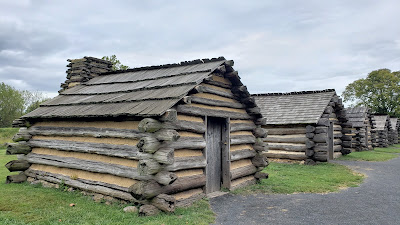Nearby city: Philadelphia, PA
"To see men without clothes to cover their nakedness, without blankets to lie on, without shoes, by which their marches might be traced by blood from their feet, and almost as often without provisions as with them, marching through the frost and snow, and at Christmas taking up their winter-quarters within a day's march of the enemy, without a horse or hut to cover them, till they could be built, and submitting to it without a murmur, is a proof of patience and obedience, which in my opinion can scarce be paralleled."
-George Washington, in a letter to John Banister dated April 21, 1778
The American Revolution had been raging for nearly two-and-a-half years, and by September 1777, prospects for a Patriot victory were looking rather grim. The Marquis de Lafayette had joined General Washington and the Continental Army a few months earlier and hoped that he could successfully persuade the French government to ally with the newly-formed nation against the British.
British General Sir William Howe, who had long occupied New York City, moved his army to attack and occupy the town of Philadelphia, where the Second Continental Congress had been meeting and running affairs for the upstart nation. Howe's forces engaged Washington's forces at the Battle of Brandywine on September 11, 1777. Washington put up stiff resistance, but Howe broke through the line and the Continental Army was forced to retreat. The Marquis de Lafayette was badly wounded, but survived. Howe would move in towards Philadelphia and occupied the city a few days later. Now, the British Army controlled and occupied yet another important colonial city.
The Second Continental Congress had evacuated the city before Howe's invasion, and relocated to the town of York, about 100 miles west of Philadelphia. Washington decided to position his army between the occupied town of Philadelphia and the town of York. The selected place was a high, flat plain south of the Schuykill River known as Valley Forge. There they would encamp during the winter of 1777-1778.
As the Continental Army began to fortify the position, they got some incredibly good news. British General John Burgoyne's army, who had advanced from British Canada south towards New York City, had been soundly defeated by Patriot General Horatio Gates at the Battle of Saratoga in upstate New York. Curiously, Howe decided not to send troops from New York City or Philadelphia to reinforce Burgoyne. The British defeat at Saratoga was so decisive, that the French government decided to join with the colonies, officially support American indepedence, and declared war on the mighty British Empire. This alliance would provide crucial military support and supplies to the American army, and would force the British to fight a two-front war, one in the colonies against America and one against the French in the West Indies and Europe.
Now, buoyed by the news of this great victory, Washington and the 12,000-strong Continental Army just needed to bunker down and get through the winter of 1777-1778 at Valley Forge. The first order of business was to construct a large-scale living quarters. The soldiers themselves constructed approximately 1,500 log huts. They weren't much, in fact, Marquis de Lafayette described them in a letter to his wife as "small barracks, which are scarcely more cheerful than dungeons." These barracks have been reconstructed at the National Park site. You can learn all about living conditions of the soldiers in these quarters.
The Continental Army was in desparate need of supplies, Washington worked hard to secure these funds from the Second Continental Congress, but it was not easy. The army also had to deal with a smallpox outbreak and inclement weather conditions. The Valley Forge encampment lasted six months, from December 19, 1777 to June 19, 1778. During that time, about 1,700-2,000 (around 15%) of the soldiers stationed there died from starvation, the winter cold, and disease.
Although it was a time of great suffering for the army, it was also a time of training and rejuvenation. A Prussian military officer, Baron Friedrich von Steuben, volunteered to lead the training of the Continental Army, and instructed them in the essentials of military drills, tactics, and discipline. This training would prove invaluable to the later successes of the Continental Army. The shared hardship of the officers and soldiers in the army helped build the espirit de corps that eventually lead to American victory. In many ways, Valley Forge was a "refiner's fire" for the Continetnal Army and a turning point for the American revolution.
Today, Valley Forge National Historical Park, created first as a state park in 1893 and later as a National Park in 1976, preserves and protects these 3,500 acres of the winter encampment. The capstone of the park is the National Memorial Arch, built in 1917, that honors the sacrifice of the troops that served and died here. It is a somber place.
Start your visit at the Visitor's Center, which has a lot of exhibits and information. Then take the tour road, that will take you throughout the Park, stopping at all the key sites and monuments. There's also some nice biking and hiking trails, the surrounding landscape is beautiful.
Stop by the statue of General "Mad" Anthony Wayne. Wayne had served with distinction during the French and Indian War. Washington heavily relied on Wayne's leadership at Valley Forge. Wayne would later lead a daring success against the British in 1779 at the Battle of Stony Point in New York.
If visiting Philadelphia area, make sure to make the journey to visit this incredible historical site. More info here: https://www.nps.gov/vafo/index.htm


















No comments:
Post a Comment